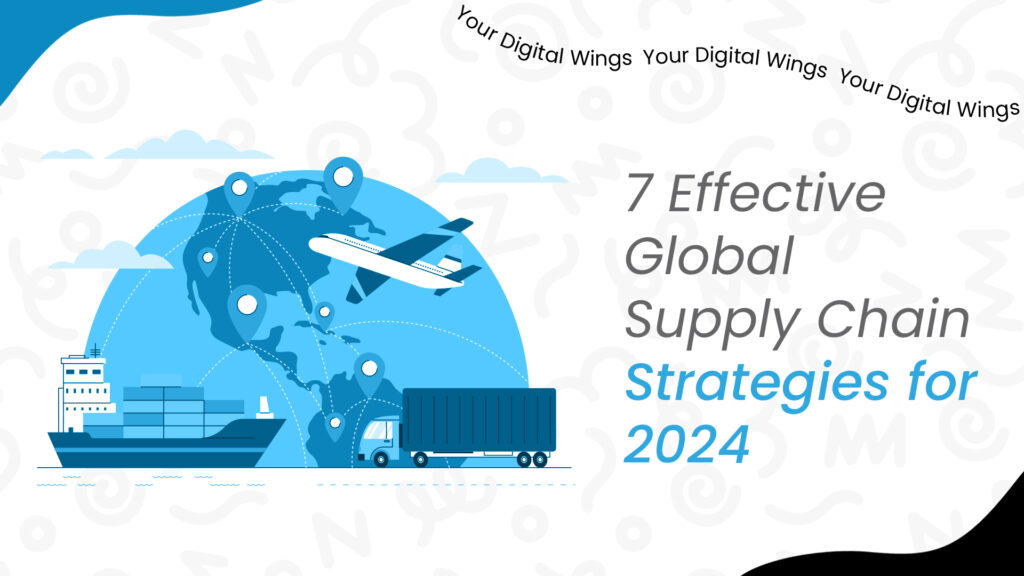In today’s rapidly evolving global market, effective supply chain management is crucial for maintaining a competitive advantage. As businesses prepare for 2024, adopting innovative and resilient supply chain strategies will be key to success. The challenges faced by Global supply chain strategies, such as disruptions from geopolitical tensions, environmental concerns, and technological advancements, require companies to be more agile, adaptive, and forward-thinking.
Effective global supply chain strategies not only address these challenges but also leverage them as opportunities for growth and improvement. By implementing these strategies, businesses can be well-positioned to navigate the complexities of the modern supply chain landscape and achieve sustained success.
1. Embracing Digital Transformation
Digital transformation revolutionizes supply chains by integrating advanced technologies such as AI (Artificial Intelligence), IoT (Internet of Things), and blockchain. AI helps in predicting demand, optimizing routes, and automating tasks, leading to more efficient operations. IoT devices provide real-time data on the location and condition of goods, enhancing visibility and allowing for better tracking and management.
Blockchain technology ensures secure and transparent transactions, reducing the risk of fraud and errors. Together, these technologies streamline operations, improve decision-making processes, and create more resilient and responsive supply chains.
Key Benefits
- Increased Efficiency: Automating routine tasks reduces human error and speeds up processes. Technologies like robotic process automation handle repetitive tasks quickly and accurately, freeing up human workers for more strategic activities.
- Enhanced Visibility: Real-time tracking of goods improves inventory management and customer satisfaction. IoT devices provide continuous updates on the location and condition of shipments, helping prevent stockouts and overstock while keeping customers informed.
- Better Decision-Making: Data analytics offer insights to optimize supply chain operations. By analyzing large datasets, businesses can predict demand, identify bottlenecks, and improve routing and logistics, leading to more informed and cost-effective decisions.
Practical Steps
- Implement AI and Machine Learning: Use AI to forecast demand and optimise inventory. AI analyzes past sales data and trends to accurately predict future demand, helping maintain optimal inventory levels.
- Adopt IoT Solutions: Use IoT devices for real-time tracking and monitoring. Sensors provide data on the location and condition of goods, ensuring they are transported and stored properly.
- Leverage Blockchain: Use blockchain for transparency and traceability. Blockchain creates a secure record of transactions and movements, reducing fraud and ensuring compliance.
2. Enhancing Supply Chain Resilience
Recent Global supply chain strategies and disruptions have highlighted the critical need for supply chain resilience. To address this, businesses should diversify their supplier base to reduce dependency on any single source. Additionally, building buffer stocks can help mitigate the impact of supply chain interruptions. Implementing robust risk management practices ensures businesses can quickly adapt and respond to unexpected challenges, maintaining operational continuity.
Key Benefits
- Risk Mitigation: Reduces dependency on single suppliers and geographic regions. By spreading sourcing across multiple suppliers and locations, businesses can minimize the impact of local disruptions on their supply chain.
- Continuity: Ensures supply chain operations continue smoothly during disruptions. This involves having systems and processes in place to keep operations running even when unexpected events occur.
- Flexibility: Adapts to changing market conditions and demands. A flexible supply chain can quickly adjust to fluctuations in demand, new market trends, and other dynamic factors.
Practical Steps
- Diversify Suppliers: Source materials from multiple suppliers across different regions. This strategy reduces the risk of supply chain interruptions due to issues like political instability, natural disasters, or production delays in a single location.
- Build Buffer Stocks: Maintain safety stock to cushion against supply chain shocks. Having extra inventory on hand helps ensure that production can continue and customer orders can be fulfilled even if there are temporary supply chain disruptions.
- Develop Risk Management Plans: Identify potential risks and create contingency plans. This involves conducting risk assessments, prioritizing risks based on their potential impact, and developing specific strategies to address each risk. Regularly reviewing and updating these plans ensures they remain effective in the face of new challenges.
3. Fostering Sustainability in Supply Chains
Sustainability is no longer a mere option but a necessity for modern supply chains. Companies must adopt eco-friendly practices to minimize environmental impact, reduce carbon footprints to combat climate change and ensure ethical sourcing to promote fair labour practices and support local communities. Embracing sustainability not only meets regulatory and consumer demands but also enhances brand reputation and long-term profitability.
Key Benefits
- Environmental Protection: Reduces negative impacts on the environment. Implementing sustainable practices helps to preserve natural resources and reduce pollution.
- Brand Reputation: Enhances company image and attracts environmentally conscious customers. Companies that prioritize sustainability can build stronger relationships with their customers and differentiate themselves from competitors.
- Cost Savings: Sustainable practices can reduce waste and improve resource efficiency, leading to significant cost savings by minimizing waste and optimizing resource use.
Practical Steps
- Implement Green Logistics: Using eco-friendly transportation options and optimise delivery routes to reduce emissions and fuel consumption.
- Reduce Waste: Adopt recycling and waste reduction practices to minimize the amount of waste generated and promote the reuse of materials.
- Ensure Ethical Sourcing: Partner with suppliers who adhere to ethical labour and environmental standards. This ensures that the supply chain is socially responsible and environmentally sustainable.
4. Leveraging Multi-Sourcing and Regionalization
By following both Online vs offline distribution strategies and Multi-sourcing and regionalisation strategies help reduce dependency on single suppliers and minimise geopolitical risks. By sourcing materials from multiple regions, companies can ensure a more stable supply chain and reduce lead times. This approach not only enhances supply chain resilience but also allows businesses to adapt more quickly to local market demands and disruptions.
Key Benefits
- Supply Stability: Reduces the risk of supply disruptions by having multiple suppliers across different regions.
- Faster Response Times: Shortens lead times by sourcing locally or regionally, ensuring quicker delivery and responsiveness to market changes.
- Economic Support: Contributes to local economies and reduces transportation costs, promoting sustainability and efficiency.
Practical Steps
- Develop a Multi-Sourcing Strategy: Identify multiple suppliers for critical components to diversify your supply base and reduce dependency on any single source.
- Regionalize Supply Chains: Establish regional supply chains closer to end markets to minimise lead times and enhance flexibility in responding to local demands.
- Negotiate Flexible Contracts: Create contracts that allow for adjustments in response to supply chain disruptions, ensuring that you can adapt quickly to unforeseen challenges and maintain continuity.
5. Enhancing Collaboration and Partnerships
Collaboration and strong partnerships are essential for an efficient supply chain. Businesses should foster close relationships with suppliers, distributors, and logistics providers to improve coordination and communication in selecting International distribution channels.
Key Benefits
- Improved Coordination: Enhances synchronization across the supply chain by aligning processes and communication between all parties involved.
- Cost Reduction: Streamlines processes and reduces operational costs through better coordination and efficiency.
- Innovation: Encourages joint development of innovative solutions by fostering collaboration and sharing of ideas.
Practical Steps
- Build Strong Relationships: Communicate regularly and collaborate with partners to ensure everyone is aligned and working towards common goals.
- Use Collaborative Platforms: Implement digital platforms that facilitate information sharing and real-time communication among supply chain partners.
- Joint Planning: Work together with partners to plan and execute supply chain strategies, ensuring that all stakeholders are involved in the decision-making process and can contribute to the overall success.
6. Utilizing Predictive Analytics and Forecasting
Predictive analytics and forecasting tools enable businesses to anticipate demand fluctuations, optimize inventory levels, and reduce waste. By leveraging big data and advanced algorithms, companies can analyze historical data and market trends to make informed decisions. This enhances supply chain agility, allowing businesses to respond quickly to changes in demand and minimize the risk of overstocking or stockouts.
Using these tools, companies can better align their supply chain operations with actual market needs, ensuring a more efficient and responsive supply chain. This proactive approach not only improves customer satisfaction by meeting demand more accurately but also reduces operational costs by minimizing excess inventory and waste.
Key Benefits
- Demand Forecasting: Anticipates customer demand and adjusts supply accordingly, helping businesses align their inventory with market needs.
- Inventory Optimization: Reduces excess inventory and minimizes stockouts, ensuring that products are available when needed without overstocking.
- Enhanced Agility: Responds quickly to market changes and customer needs, allowing businesses to adapt swiftly to new trends and demands.
Practical Steps
- Adopt Predictive Analytics Tools: Use software solutions for data analysis and forecasting to leverage big data and advanced algorithms in decision-making.
- Train Staff: Ensure employees are trained to use predictive analytics tools effectively, maximizing the benefits of these technologies.
- Continuously Monitor Data: Regularly update and analyze data to refine forecasts, ensuring that predictions remain accurate and relevant over time.
7. Optimizing Inventory Management
Effective inventory management ensures that businesses maintain the right balance between supply and demand. This involves having enough stock to meet customer needs without holding excess inventory that ties up capital. Implementing just-in-time (JIT) inventory systems allows companies to receive goods only as they are needed in the production process, reducing inventory costs and minimizing waste.
Automated replenishment systems use real-time data to automatically reorder stock when levels fall below a certain threshold, ensuring a constant supply without manual intervention. Advanced inventory tracking technologies, such as RFID and barcode scanning, provide accurate, real-time information on inventory levels and locations. These practices help minimize stockouts, where products are unavailable for sale, and overstock situations, where excess inventory leads to increased storage costs and potential obsolescence.
Key Benefits
- Cost Savings: Maintains optimal inventory levels, reducing holding costs and waste. Avoids expenses like warehousing, insurance, and obsolescence, freeing up capital for other uses.
- Improved Customer Satisfaction: Ensures products are available when needed, building trust and loyalty. Reliable stock availability reduces stockouts, enhancing the customer experience and promoting repeat business.
- Efficient Operations: Streamlines inventory processes, improving accuracy and reducing errors. Advanced tracking technologies like RFID and barcodes provide real-time data, leading to smoother operations and higher productivity.
Practical Steps
- Implement JIT Systems: Align inventory levels with actual demand to reduce excess stock, minimizing storage costs and waste.
- Use Automated Replenishment: Automate the reordering process to maintain optimal inventory levels, ensuring that products are always available without overstocking.
- Invest in Inventory Tracking: Utilize RFID and barcode technologies for real-time inventory tracking, providing accurate and up-to-date information on stock levels and locations.
Conclusion
Implementing these seven strategies can significantly enhance the efficiency and resilience of Global supply chain strategies in 2024. By embracing digital transformation, focusing on sustainability, and leveraging predictive analytics, businesses can navigate the complexities of the Global supply chain strategies and achieve sustained growth. Adopting these practices will not only optimise operations but also build a more adaptable and robust supply chain capable of meeting future challenges.
FAQs
What are the key components of a successful global supply chain strategy?
The key components include digital transformation, supply chain resilience, sustainability, multi-sourcing, collaboration, predictive analytics, and optimised inventory management.
How can businesses enhance the resilience of their supply chains?
Businesses can enhance resilience by diversifying their supplier base, building buffer stocks, and implementing robust risk management practices.
What are the benefits of adopting sustainable supply chain practices?
Sustainable supply chain practices protect the environment, enhance brand reputation, and improve customer loyalty.

 United Arab Emirates
United Arab Emirates